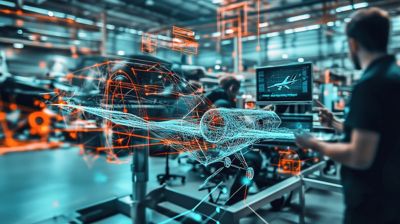-
-
Access Free Student Software
Ansys empowers the next generation of engineers
Students get free access to world-class simulation software.
-
Connect with Ansys Now!
Design your future
Connect with Ansys to explore how simulation can power your next breakthrough.
Countries & Regions
Free Trials
Products & Services
Learn
About
Back
Products & Services
Back
Learn
Ansys empowers the next generation of engineers
Students get free access to world-class simulation software.
Back
About
Design your future
Connect with Ansys to explore how simulation can power your next breakthrough.
Free Trials

If you were to take apart an autonomous system, what would you find? You’d quickly see the hardware components that enable the autonomous system to perform its mission, such as sensing and perception systems. You would not, however, be able to see a part of the system’s design that is equally important: software.
The software used in autonomous systems in the aerospace and defense (A&D) industry is both incredibly complex — sometimes requiring developers to continuously and rapidly validate billions of lines of code — and quickly becoming more diverse. As such, this software can vary greatly depending on the type of autonomous system you’re working with.
Despite this diversity, there are a few core software types used in autonomous systems, which range from embedded software and control systems to connectivity and communication software. These key software types are:
- Data fusion, sensor fusion, and processing software for improving data quality and extracting actionable insights
- Decision-making and planning software to automate those tasks in real time
- Command, control, and intelligence (C2I) software for enhancing a system’s ability to analyze complex data and provide decision support
- Execution and control software for learning from ongoing operations and then adjusting execution strategies for optimal performance
- Connectivity software for ensuring that autonomous systems can connect and share important information and data with other systems via transmitter-receiver (Tx/Rx) devices
- Network quality, cloud, and edge computing for building robust, high-quality communication networks with optimized system performance, secure connections, and scalability
- Middleware and glue code for enabling different connectivity systems to have full interoperability and seamless integration
- Chip design and certification for ensuring that all the elements mentioned above can achieve sufficiently high and reliable performance
Let's briefly discuss the goals and challenges of working with autonomous software.

What Are the Objectives of the Software Used in Autonomous Systems?
No matter its specific functionality, all the software lying beneath the surface of an autonomous system in the A&D industry needs:
- High levels of responsiveness and performance to work in the dynamic and challenging environments that A&D systems exist within
- Seamless connectivity and the ability to communicate with external software and networks
- Proper integration with the hardware as part of the overall autonomous system
- Actionable data from sensors and artificial intelligence (AI) for real-time data processing, adaptive decision-making, and intelligent control
- The ability to be scalable as well as to quickly grow and evolve, which can involve the use of continuous integration/continuous deployment (CI/CD) and over-the-air (OTA) updates
These goals hold true no matter the type of software you are developing.

Key Challenges in Software Development: Integration and Standardization
As autonomous systems in the A&D industry become more complex, their software must also rapidly evolve to match this pace of innovation. To do so, software developers need to overcome a few persistent challenges.
First, all software must be compliant, achieve all needed certifications, and have proper identification of failure modes. With autonomous technology changing quickly, this has become a major obstacle due to the lack of dedicated standards and common practices like use of in-house and third-party tools. At the same time, autonomous software also needs to achieve improved processing power, performance, and optimized size, weight, power, and cost (SWaP-C).
Another hurdle engineers face is ensuring proper software integration, which is a particularly complicated and costly part of the development life cycle. Adding to this is the fact that integration is multifaceted and must occur between the embedded software of a single system and between a system and external systems.
Conquering all of these challenges will not be easy, but it is an integral part of creating an accurate, safe, and effective final design.

Achieving New Levels of Innovation With Digital Engineering
Looking ahead to the future generations of autonomous software, we will see systems that are increasingly responsive, dynamic, robust, safe, and able to form standardized connections. To achieve this future, researchers, engineers, and developers are increasingly turning toward digital engineering.
With digital engineering, engineers gain the ability to understand how their autonomous systems will perform in the physical world by using a trusted virtual model-based environment. Further, digital engineering enables software to be developed while improving performance and accuracy; ensuring safety, reliability, consistency, and compliance; increasing interdisciplinary collaboration and communication; and reducing time and costs — better helping innovators usher in the next generation of autonomous software.
Ready to learn more about the use of autonomous technology in A&D? Download the "Designing Optimized Software Stacks for Autonomous Systems in Aerospace and Defense" e-book and visit Autonomous Systems for A&D.
Learn More
Ready to learn more about the use of autonomous technology in A&D? Download the "Designing Optimized Software Stacks for Autonomous Systems in Aerospace and Defense" e-book.
The Advantage Blog
The Ansys Advantage blog, featuring contributions from Ansys and other technology experts, keeps you updated on how Ansys simulation is powering innovation that drives human advancement.


